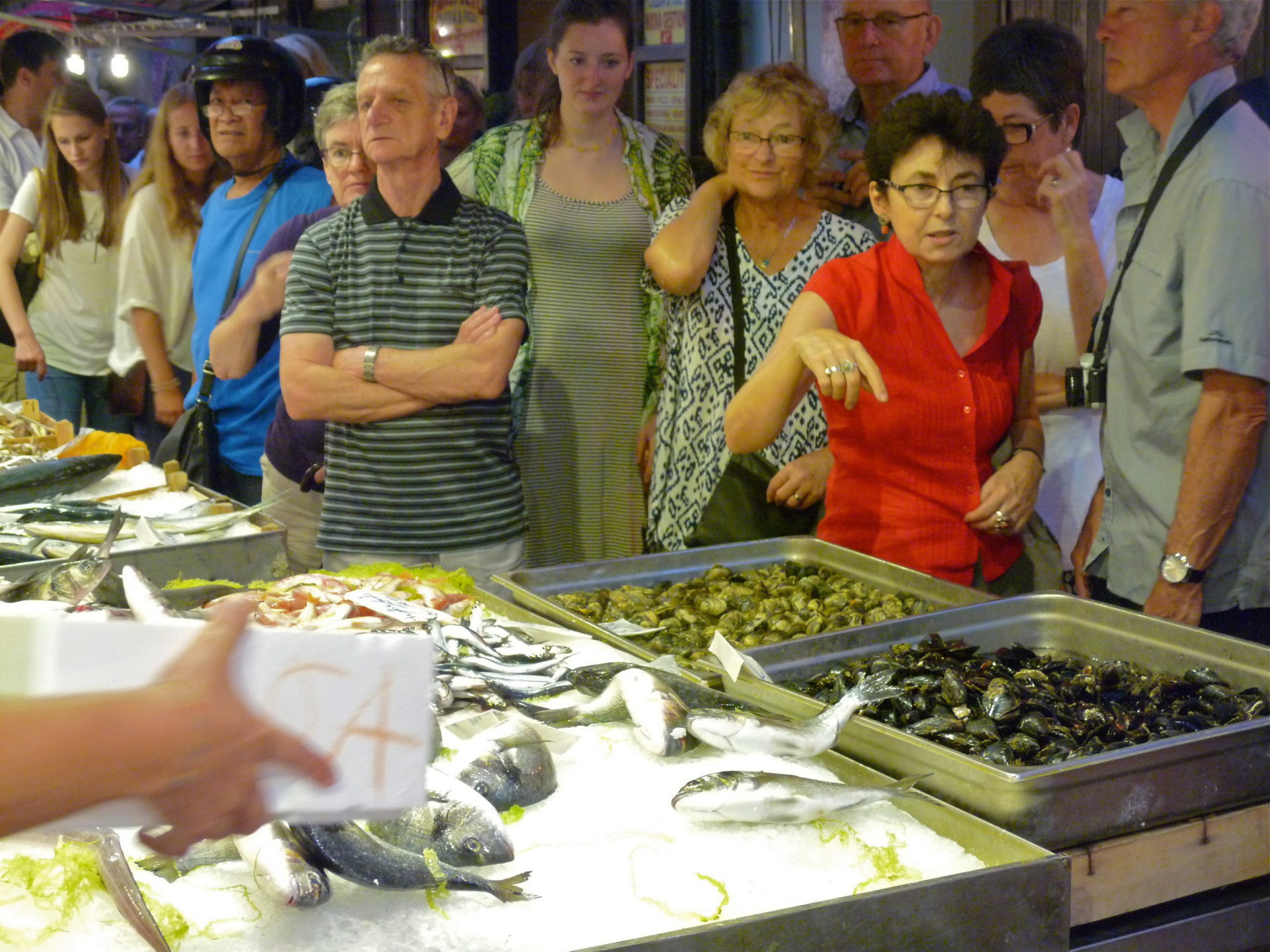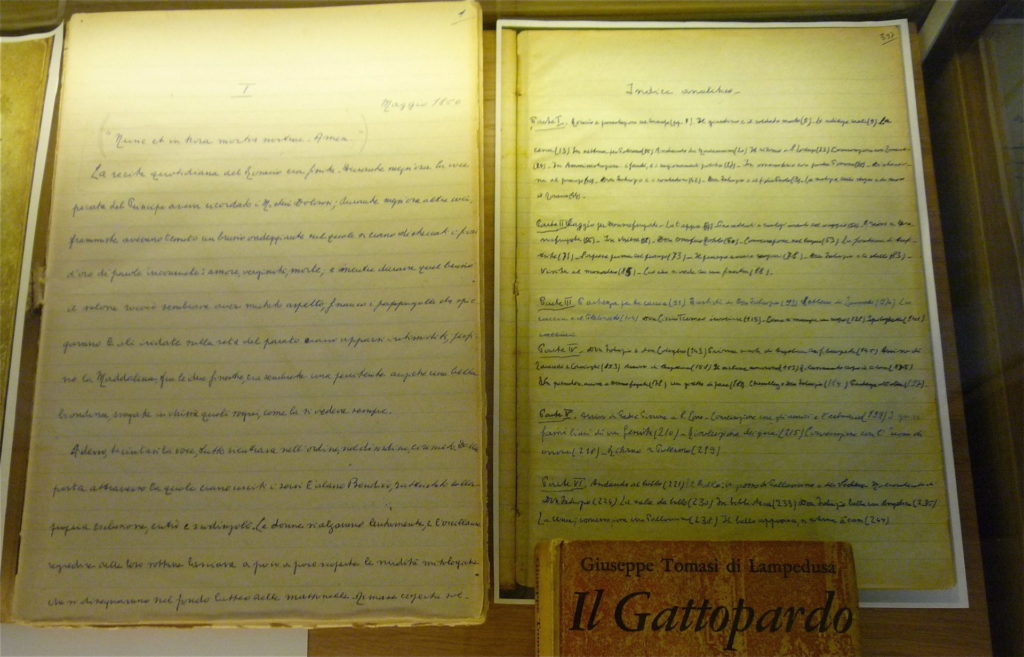






Dear Shaded Viewers,
At the start of “Cooking with the Duchess,” a Sicilian cooking class taught by Nicoletta Polo Lanza Tomasi, the Duchess made a startling pronouncement—she had promoted herself to Queen. “You remember what the Queen of Hearts in Alice in Wonderland says, don’t you?” the Duchess of Palma, resplendent in a bright-red blouse to drive the point home, asked us. “’Off with their heads!’ And that’s what will happen to you if you make a mistake.”
Somehow I managed to keep my head even though, klutz that I am, I neglected to dry off the parsley in the salad spinner. But there were plenty of chances to redeem myself as the long, detailed and highly enjoyable class continued on in Nicoletta’s warm kitchen in her splendid home, the Palazzo Lanza Tomasi.
The 7-hour experience began with herb gathering in Nicoletta’s garden and continued on with a trip to the storied Mercato il Capo for the main ingredients, preparation in the kitchen, and a silver-service lunch that was book-ended with tours of the palazzo, which happens to be the last home of Prince Giuseppe di Lampedusa, author of the celebrated Sicilian novel The Leopard.
Nicoletta is a self-taught cook and even though she is originally from Venice, her knowledge of Sicilian cuisine is formidable. She moved to Palermo in the early 1980s and has lived in Naples and also New York for a few years.
Nicoletta Polo Lanza Tomasi, the Duchess of Palma di Montechiaro, in her garden at the Palazzo Lanza Tomasi, September 9, 2015.
Time to make the panelle (chickpea fritters).

Watermelon from the market and fresh jasmine blossoms from Nicoletta’s garden for our divoon watermelon pudding.
Preparing the stuffing for the involtini di pesce spada (swordfish rolls) was a lot of work. One step involved zesting the lemons.
Mixing and heating the chickpea batter for the panelle.
Nicoletta pontificates on the art of jasmine-flower infusing. The watermelon juice was steeped with the fragrant, young blossoms for a few hours before being strained, poured into champagne glasses and chilled.
Ingredients for the swordfish rolls stuffing: dried currants, pine nuts, parsley (you can also use mint), lemon zest and fresh bay leaves (which I helped pick in the garden). Other ingredients included red onion and mashed anchovy fillets.
“The red oval onions are Tropea onions,” Nicoletta explained. “They are ‘protected by law.’ They are IGP (Indicazione Geografica Protetta) which means they’re the only kind of onion grown uniquely in the territory of Tropea, in Calabria, that can be called, according to law, cipolla di Tropea, Tropea onion. They are usually sold in a bunch tied by a seal. They are much sweeter than the regular onions.”
Scooping the hot chickpea batter into a can to mold it. After it cooled, it was sliced into a thin pieces that were pan-fried.
The entrance to Mercato il Capo, one of Palermo’s oldest markets. We were in a bit of a rush to beat the rain (it started pouring as we were leaving) but we still had time to listen to all of Nicoletta’s stories about the market and visit a beautiful church, Chiesa dell’Immacolata Concezione, known for its gorgeous colored marble inlays, which is tucked away behind the tarps and scaffolding of the market.
The name of the market, il Capo, comes from “Caput Seralcadii” or, the higher part of Seralcadio. Seralcadio was the original name of the area, from the Arabic Sari-al-Qadi (the street of the Kadi).

Nicoletta scores some bread from her favored bakery. One can’t be fickle in the markets of Palermo. When you buy bread or fish or vegetables, one always go to the same stands. You are “owned” by those vendors. If you dare to change your routine and patronize a rival vendor, it’s considered a “slash across the face” to the one who owns you—a serious insult. And of course, you are treated very well by your “owners.” If they are expecting you on a certain day, they will make sure they reserve some of your usual items.
When we returned from the market, the servants had laid out a tantalizingly toothsome array of Sicilian marzipan, served with coffee or green tea.
Cooking the watermelon juice and cornstarch for the pudding.

In Sicily, cooks do not even consider capers that are preserved in vinegar. They are regarded as low quality. Sicilian capers are preserved in salt which is rinsed off thoroughly before use.
We spent some time peeling the skins off these baby potatoes for this gorgeously simple salad, which included those sweet red onions and capers. The recipe hails from Pantelleria, an island in the Strait of Sicily. The dressing of red-wine vinegar, extra-virgin olive oil and freshly ground pepper was added right before serving to avoid soggy-salad syndrome.
Nicoletta whipped up a batch of Trapanese-style pesto: Roma (or San Marzano) tomatoes, blanched and peeled almonds, fresh basil, freshly ground pepper, salt and, of course, extra-virgin olive oil. It was served with ruvidelli pasta, garnished with breadcrumbs, and it was divoon.
We took a break from cooking to indulge in some heavenly canapes and Sicilian wine.
The swordfish rolls were the most complicated dish we prepared. The competition to tuck and roll the perfect one was fierce.
After the watermelon pudding chilled, we decorated it with chocolate chips that are meant to mimic the melon’s seeds.
The table is set for lunch. Gorgeous, si?

The swordfish rolls were coated in breadcrumbs and fried. I was over the moon for them!

Moi enjoying the fruits of our labor. Unfortunately, the Duke of Palma was in Syracuse (he is the director of the opera house there) but I had a lovely chat with the charming Australian women who were in the class.

After lunch, we adjoined to the ballroom where the Duchess told us about the history of the palazzo, which was built in the second half of the 17th century atop the Spanish military casements behind the 16th-century city walls. Nicoletta’s husband, the Duke of Palma, Gioacchino Lanza Tomasi, has unified the whole property and thoroughly restored the building. The furnishings of the ballroom and the writer’s library are mostly from the destroyed (by the Allied Forces in 1943) Lampedusa palace, the home of Giuseppe di Lampedusa, the Duke’s adoptive father, who lived in the Palazzo Lanza Tomasi in the ’40s and ’50s. He died before his great novel, The Leopard, was published.
The main charm of the Palazzo Lanza Tomasi rests in its location and the grandeur of the serene space and glorious sunlight. Its interior decoration is typical of the great houses of Palermo’s aristocracy and contains a valuable collection of furnishings from the great Sicilian cabinet makers.
It was great fun discussing various aspects of both the novel and the film versions of The Leopard. We had a moment of gallows humor concerning the part of the story where Tancredi is trying to frighten the timid bureaucrat from Turin. “The parish priest was killed in there five years ago as he was saying Mass.”
“Horrors! Shooting in church!”
“Oh, no shooting, Chevalley. We are too good Catholics for misbehavior of that kind. They just put poison in the Communion wine; more discreet, more liturgical, I might say.”
The Duchess and I had a good belly laugh over that.
What a thrill it was to examine Lampedusa’s handwritten pages for The Leopard, as well as a copy of the book’s first edition.


A beautiful portrait of the Duke of Palma’s mother. “My mother-in-law Conchita was Spanish, the daughter of Marques Venceslas Ramirez de Villa Urrutia,” Nicoletta explains. “He was an important Spanish diplomat, historian, politician and bibliophile, and he was also Foreign Minister during the reign of Alfonso 13th. Conchita was extremely beautiful, lovely, witty, well-read, multilingual. She never set her foot in a kitchen in her life. She loved music, art and literature. When she was young, Picasso painted a portrait of her but her mother gave it back to him—she didn’t like it. In this portrait, painted in Venice in 1927, she is holding her first baby, Giuseppe, Gioacchino’s brother, who passed away two years ago.”
The entrance stairway to the palazzo.

Portrait of Giuseppe di Lampedusa’s great-grandfather, Prince Giulio Fabrizio Tomasi, who is the inspiration for Don Fabrizio in The Leopard. Nicoletta remarked how the portrait rather resembles Burt Lancaster, who plays the title role in Luchino Visconti’s film version of the novel.


Visiting Palermo? Here’s the info on Cooking with the Duchess: http://www.butera28.it/cooking-with-the-duchess.php
You can also rent an amazing apartment in the palazzo: http://www.butera28.it/appartamenti.php
Thank you for reading.
Baci,
